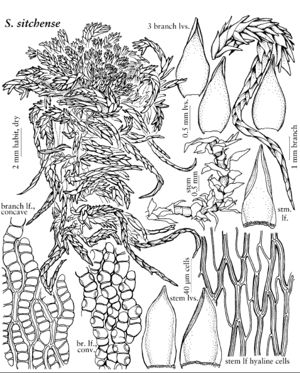Sphagnum sitchense
Sida 22: 969, figs. 27–34. 2006,.
Plants moderate-sized; capitulum flat-topped and dense; pale yellow and pink, lacking sheen. Stem pink, superficial cortical cells aporose. Stem leaves narrowly triangular to lingulate- triangular, 1.2–1.6 × 0.6–0.8 mm, length: width ratio ca. 2:1, apex apiculate, border strong and moderately broadened basally; hyaline cells narrowly rhomboid and 1 to occasionally 2 septate, often fibrillose apically. Branches not 5-ranked. Branch fascicles with 2 spreading and 1 pendent branch. Branch leaves 1.3–1.5 × 0.5–0.55 mm, ovate-lanceolate, concave, straight, apex involute; hyaline cells on convex surface with numerous round to elliptic pores along the commissures, grading from large elliptical pores at the base to moderate-sized round pores at the apex, concave surface with a few large round pores scattered throughout. Sexual condition unknown.
Habitat: Known only from type locality where it was forming low dense hummocks in alpine tundra
Elevation: moderate elevations
Discussion
Selected References
None.

